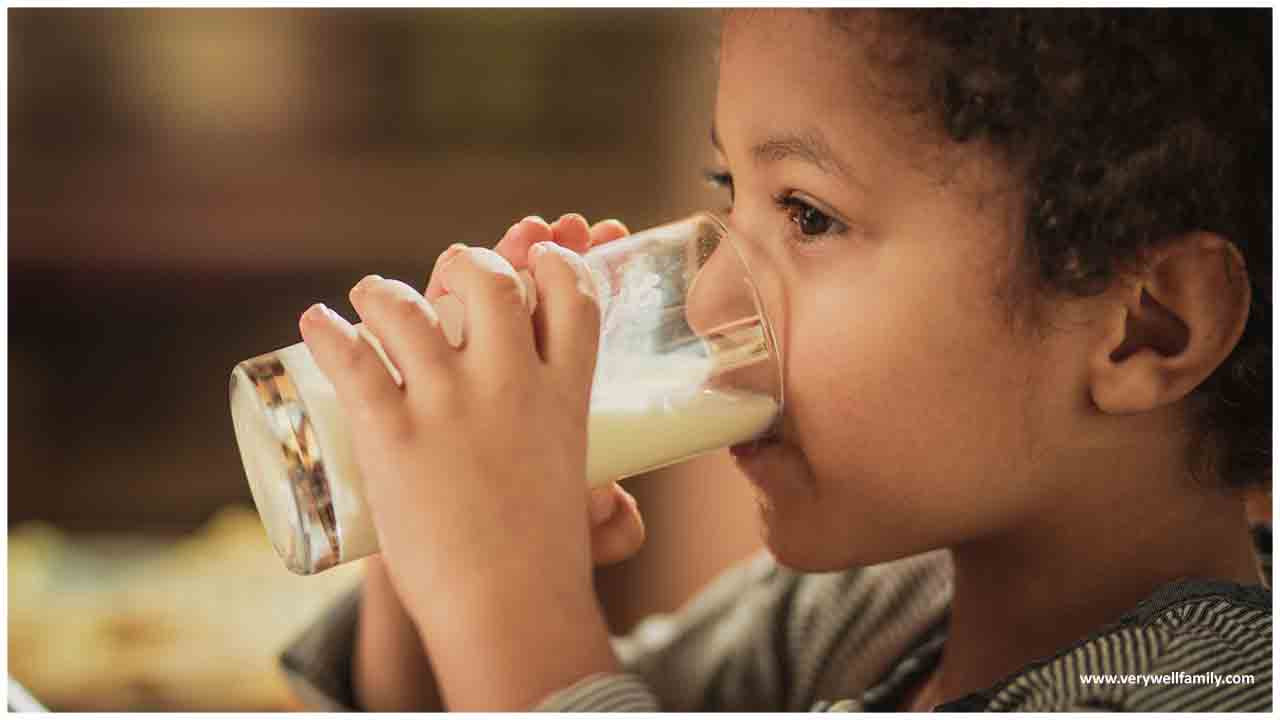Cow’s milk has a significant wellspring of good quality protein just as of calcium. Also, it has growth-promoting effects independent of specific compounds. Its protein and fat composition, along with the micronutrient content, is suggestive of useful food, whose beneficial outcomes are underlined by standard utilization.
It is known that cow's milk should not be given to babies before they are 1 year old. This is because cow's milk doesn't provide enough of certain nutrients and, it's hard for your baby to digest the protein and fat in cow's milk but it is safe to give cow's milk to children after they're 1 year old.
A child who is 1 or 2 years old should drink whole milk only. This is because the fat in whole milk is required for your child's developing brain. After 2 years old, children can move onto low-fat or skim milk if the parents are trying to take charge of them being overweight.
Issues in children drinking cow’s milk
- Milk allergy
Some children have problems with drinking cow's milk. For instance, a milk allergy may cause:
- Diarrhea
- Belly pain
- Cramping
- Nausea
- Vomiting
- A severe allergy can cause bleeding in the intestines that can lead to anemia.
But only about 1 - 3% of children below 1 year old have a milk allergy. It is even less common in children who are older than 1 to 3 years.
- Lactose intolerance
This occurs when the small intestine does not make enough of the enzyme lactase which leads to the child who is unable to digest lactose which is a type of sugar found in milk and other dairy products due to which there is bloating and diarrhea.
Children generally do not show allergies or intolerances by the time they are 1 year old. But having one food allergy increases the risk of having other types of allergies. Like in the case of dairy milk, soy milk is advised as an alternative but many children who are allergic to milk are also allergic to soy.
- Metabolic disorders
Cow's milk is a foreign substance that has spread to every corner of our diets be it artificial infant feeds or finding its way into a mother's breast milk through the foods she eats.
As it turns out, health problems such as obesity, colic, heart ailments, childhood diabetes, bowel disease, osteoporosis, cataracts, ear infections, hyperactivity, and cancer are on the rise in both children and adults, and they can be strongly linked to infant feeding choices.
While there are quite a few research studies, that point out that milk is hazardous, the dairy industry goes to great lengths to forestall any damaging rumors and statements, by saying, "No scientific research is available to back up these claims." And since there has been a long and successful history of the dairy promotion, these are readily accepted by the public but more people need to dig into real research and learn the truth by themselves.
- The difference in protein content
The high protein content in cow's milk also leads to problems. The proteins in cow's milk are different from human milk proteins and cause problems of:
- Digestion
- Intolerance
- Impaired absorption of other nutrients
- Autoimmune reactions.
Few of the proteins meant for baby cows are naturally present in human mother's milk, and none are found in any natural adult human food.
- Fats and cholesterol
Human babies need saturated fats and cholesterol in the mother's milk for their growth and development. Bovine milk fat is not appropriate for human babies’ consumption and is only harmful to the health of children and adults.
- Pesticides and pollutants
Cows also concentrate pesticides and pollutants into their milk fat, from their high dietary food and water requirements. The high amount of drugs now given to cows adds to this chemical concoction.
- Hormones
Cow hormones are not meant for humans, and older children and adults are not meant to consume hormones as cows have been selectively bred over time to create high levels of these hormones to make the cows grow faster and produce large amounts of milk.
Decoding Dairy for you
The highly promoted idea that milk builds strong bones refers to the prevention of but in reality, heavy milk consumption is associated with an increased rate of osteoporosis. Decades of effort to demonstrate that high calcium diets chiefly derived from dairy products build strong bones have failed to prove any such correlation.
In fact, the opposite seems to be of truth. It is studied that high calcium intake before puberty, and especially in young childhood, may have a slight positive effect on bones. But a balanced intake of all the bone minerals, along with adequate vitamins A, C, D, and K, is truly needed to strengthen the bones.
- A balanced intake of minerals cannot occur when the diet emphasizes dairy as high calcium causes deficiencies in magnesium and other bone-building minerals, and its high phosphorus and animal protein leads to reduced calcium availability.
- Physical activity is of utmost benefit for bones - the body efficiently uses what is available to build strong bones when it senses the need.
- Human milk and vegetable sources are superior to dairy for calcium and other nutrients in many ways. There are lesser nutritional or health advantages of cow's milk to children than is generally believed.
Almost every other day new health research comes out about whole grains, a serving of vegetables, two fruits per day, or some other food, other than milk, and their connection to a reduced risk of heart disease, stroke, breast cancer, diabetes, and so on since, it leads to insufficient intake of important vitamins, several minerals, and healthy fiber and vegetable oils.
Cancer-preventing antioxidants in foods are missing in this milk for which vitamin A is added to milk (not all dairy products), it is likely counteracted by the pesticide and drug residues.
The full complement of vitamin A and associated enzymes, found in vegetables and other foods, are required for cancer prevention. Many, many more kinds of antioxidants are found in vegetables, legumes, fruits, and grains. Think about this, no other animal in the animal kingdom drinks milk beyond childhood.
Think about it, no animal suffers from osteoporosis, except the ones who are raised as pets on human meals.
Organic raw whole milk is the best choice
If a parent desires to provide milk to a child who has no diarrhea, rashes, or other intolerance reactions, organic raw whole milk would be the best choice.
Commercial raw milk can contain a leukemia virus, but this virus cannot perpetuate among drug-free raw milk cow sources while in raw (unpasteurized) milk there will be healthy flora and more active forms of immune agents. While in organic milk there are lesser antibiotic residues, hormones as cows are given better feeds.
In fact it is not true that raw milk contains helpful lactase enzymes only curdled or other high-bacteria versions will contain some; produced by the bacteria.
So what we feed our children matters and how we parent them is of importance thus knowing and avoiding the potentially harmful effects that high dairy consumption and milk-sensitivity reactions can have on your child is just as important as raising them and loving them. Parents need to make informed health care decisions so that it will lead to the best health, comfort, and happiness available to a child.

 Think about it, no animal suffers from osteoporosis, except the ones who are raised as pets on human meals.
Think about it, no animal suffers from osteoporosis, except the ones who are raised as pets on human meals.









.jpeg)



.jpg)




.jpg)





.jpeg)

.jpg)


